Projectile Motion Analysis: Distance, Error, and Angle of Projection
VerifiedAdded on 2023/01/18
|8
|1989
|21
Homework Assignment
AI Summary
This physics assignment delves into the analysis of projectile motion, examining the horizontal distance traveled by a projectile launched from different heights (top, middle, and bottom levels). The solution utilizes equations of motion to calculate the time of flight and horizontal distance, considering the impact of initial velocity and angle of projection. Furthermore, the assignment explores error analysis by comparing theoretical calculations with measured data, quantifying the error percentage associated with variations in velocity, height, and angle. The analysis reveals the sensitivity of horizontal distance to these parameters, particularly the angle of projection. The assignment concludes by optimizing the angle of projection to maximize horizontal distance and provides a comprehensive summary of the findings, including limitations and conclusions. This assignment is a comprehensive analysis of projectile motion, covering both theoretical calculations and practical error analysis.

PART A
i)
When the ball is hit from the top level.
The ball travels a total vertical distance of h units. So we can find out the time of the travel for the
ball with the help of the equation of motion. (Academy, 2019)
−h= ( v sin θ ) tt − 1
2 g tt
2
Where g is the acceleration due to gravity. The upward direction is considered to be positive so
downward directions are negative which justifies the negative and the positive sign in the above
equation.
−h= ( v sin θ ) tt − 1
2 g tt
2
1
2 g tt
2− ( v sin θ ) tt −h=0
tt=v sinθ ± √ v2 ¿ ¿ ¿
So, the time which is feasible is
tt=v sinθ + √v2 ¿ ¿ ¿
So the horizontal distance travelled is dt
Now we can write the equation of motion in the horizontal direction as,
dt = ( v cos θ ) tt
dt = ( v cos θ ) v sin θ+ √v2 ¿ ¿ ¿
When the ball is hit from the middle level
The ball travels a total vertical distance of h/2 units. So we can find out the time of the travel for the
ball with the help of the equation of motion
−h
2 = ( v sin θ ) tm− 1
2 g tm
2
Where g is the acceleration due to gravity. The upward direction is considered to be positive so
downward directions are negative which justifies the negative and the positive sign in the above
equation.
−h
2 = ( v sin θ ) tm− 1
2 g tm
2
1
2 g tm
2− ( v sin θ ) tm −h
2 =0
tm=v sin θ ± √ v2 ¿ ¿ ¿
i)
When the ball is hit from the top level.
The ball travels a total vertical distance of h units. So we can find out the time of the travel for the
ball with the help of the equation of motion. (Academy, 2019)
−h= ( v sin θ ) tt − 1
2 g tt
2
Where g is the acceleration due to gravity. The upward direction is considered to be positive so
downward directions are negative which justifies the negative and the positive sign in the above
equation.
−h= ( v sin θ ) tt − 1
2 g tt
2
1
2 g tt
2− ( v sin θ ) tt −h=0
tt=v sinθ ± √ v2 ¿ ¿ ¿
So, the time which is feasible is
tt=v sinθ + √v2 ¿ ¿ ¿
So the horizontal distance travelled is dt
Now we can write the equation of motion in the horizontal direction as,
dt = ( v cos θ ) tt
dt = ( v cos θ ) v sin θ+ √v2 ¿ ¿ ¿
When the ball is hit from the middle level
The ball travels a total vertical distance of h/2 units. So we can find out the time of the travel for the
ball with the help of the equation of motion
−h
2 = ( v sin θ ) tm− 1
2 g tm
2
Where g is the acceleration due to gravity. The upward direction is considered to be positive so
downward directions are negative which justifies the negative and the positive sign in the above
equation.
−h
2 = ( v sin θ ) tm− 1
2 g tm
2
1
2 g tm
2− ( v sin θ ) tm −h
2 =0
tm=v sin θ ± √ v2 ¿ ¿ ¿
Paraphrase This Document
Need a fresh take? Get an instant paraphrase of this document with our AI Paraphraser
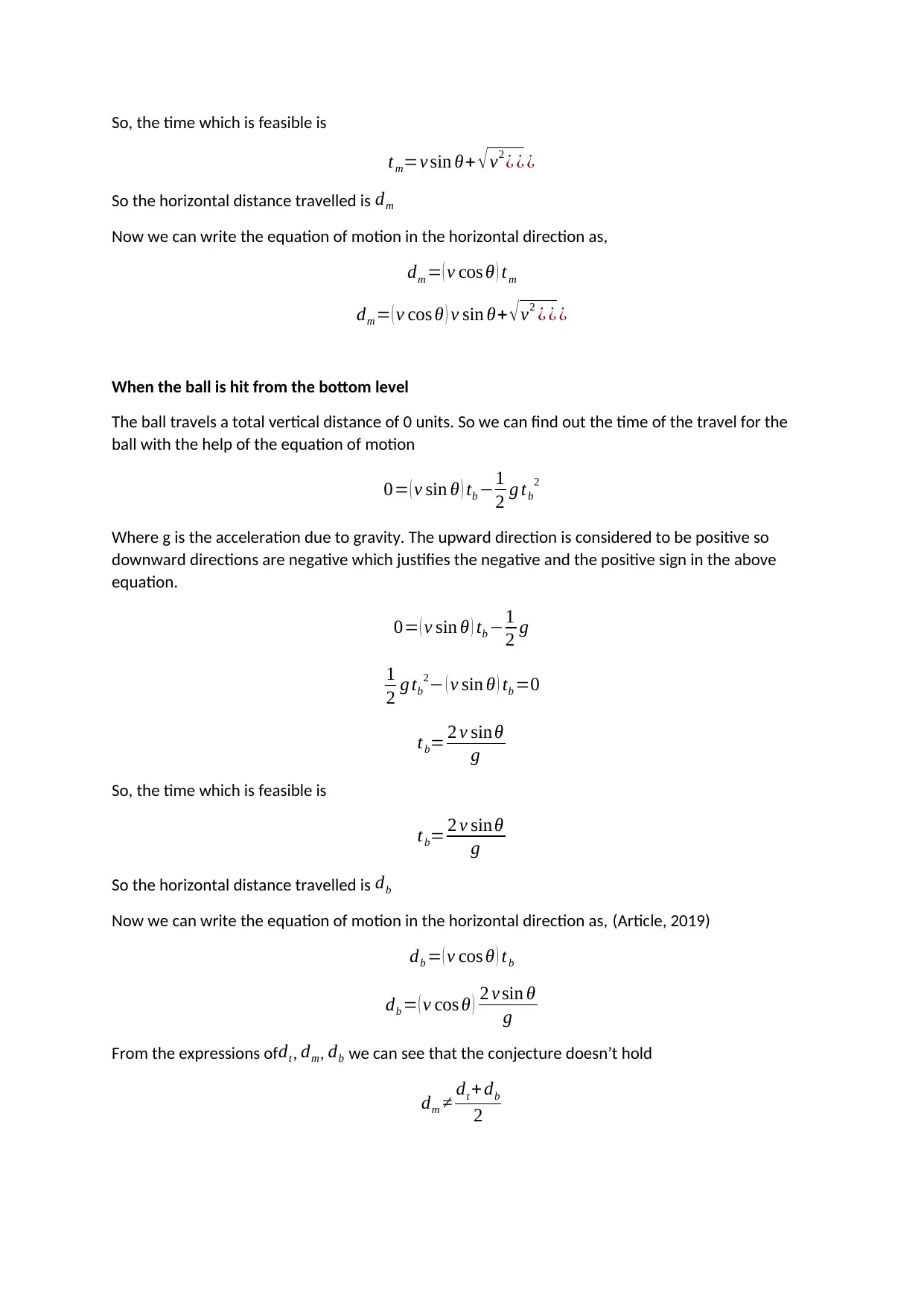
So, the time which is feasible is
tm=v sin θ+ √ v2 ¿ ¿ ¿
So the horizontal distance travelled is dm
Now we can write the equation of motion in the horizontal direction as,
dm = ( v cos θ ) t m
dm = ( v cos θ ) v sin θ+ √ v2 ¿ ¿ ¿
When the ball is hit from the bottom level
The ball travels a total vertical distance of 0 units. So we can find out the time of the travel for the
ball with the help of the equation of motion
0= ( v sin θ ) tb −1
2 g tb
2
Where g is the acceleration due to gravity. The upward direction is considered to be positive so
downward directions are negative which justifies the negative and the positive sign in the above
equation.
0= ( v sin θ ) tb −1
2 g
1
2 g tb
2− ( v sin θ ) tb =0
tb= 2 v sinθ
g
So, the time which is feasible is
tb= 2 v sinθ
g
So the horizontal distance travelled is db
Now we can write the equation of motion in the horizontal direction as, (Article, 2019)
db = ( v cos θ ) t b
db = ( v cos θ ) 2 v sin θ
g
From the expressions ofdt, dm, db we can see that the conjecture doesn’t hold
dm ≠ dt + db
2
tm=v sin θ+ √ v2 ¿ ¿ ¿
So the horizontal distance travelled is dm
Now we can write the equation of motion in the horizontal direction as,
dm = ( v cos θ ) t m
dm = ( v cos θ ) v sin θ+ √ v2 ¿ ¿ ¿
When the ball is hit from the bottom level
The ball travels a total vertical distance of 0 units. So we can find out the time of the travel for the
ball with the help of the equation of motion
0= ( v sin θ ) tb −1
2 g tb
2
Where g is the acceleration due to gravity. The upward direction is considered to be positive so
downward directions are negative which justifies the negative and the positive sign in the above
equation.
0= ( v sin θ ) tb −1
2 g
1
2 g tb
2− ( v sin θ ) tb =0
tb= 2 v sinθ
g
So, the time which is feasible is
tb= 2 v sinθ
g
So the horizontal distance travelled is db
Now we can write the equation of motion in the horizontal direction as, (Article, 2019)
db = ( v cos θ ) t b
db = ( v cos θ ) 2 v sin θ
g
From the expressions ofdt, dm, db we can see that the conjecture doesn’t hold
dm ≠ dt + db
2

ii)
Let us consider the value of velocity and the height,
g=9.8 m/s2
v=14 m/ sec
h=10 m
Let us consider the top level and the horizontal distance travelled by it
dt = ( v cosθ ) v sin θ+ √ v2 ¿ ¿ ¿
Putting the values,
dt =196 sin θ cos θ+14 cos θ √196 ¿ ¿ ¿
dt =196 sin θ cos θ+196 cos θ √¿ ¿ ¿
dt =20 ¿
If we want to optimize the horizontal distance when thrown from the top level we get,
d dt
dθ = ((cos θ)2−(sin θ)2 )−sin θ √¿ ¿
1−2(sinθ)2 −sin θ ¿
1−2(sinθ)2 −sin θ ¿
(1−2(sin θ)2 ) 2
¿
Solving we get,
(sin θ)2= 1
3
sin θ= 1
√3
Therefore,
θ=35.26 °
When we are trying to maximize the horizontal distance when thrown from the top level
Putting the values of θ obtained in the horizontal distance we get,
dt =20 ¿
dt =20 √2=28.28 m
Let us consider the value of velocity and the height,
g=9.8 m/s2
v=14 m/ sec
h=10 m
Let us consider the top level and the horizontal distance travelled by it
dt = ( v cosθ ) v sin θ+ √ v2 ¿ ¿ ¿
Putting the values,
dt =196 sin θ cos θ+14 cos θ √196 ¿ ¿ ¿
dt =196 sin θ cos θ+196 cos θ √¿ ¿ ¿
dt =20 ¿
If we want to optimize the horizontal distance when thrown from the top level we get,
d dt
dθ = ((cos θ)2−(sin θ)2 )−sin θ √¿ ¿
1−2(sinθ)2 −sin θ ¿
1−2(sinθ)2 −sin θ ¿
(1−2(sin θ)2 ) 2
¿
Solving we get,
(sin θ)2= 1
3
sin θ= 1
√3
Therefore,
θ=35.26 °
When we are trying to maximize the horizontal distance when thrown from the top level
Putting the values of θ obtained in the horizontal distance we get,
dt =20 ¿
dt =20 √2=28.28 m
⊘ This is a preview!⊘
Do you want full access?
Subscribe today to unlock all pages.

Trusted by 1+ million students worldwide
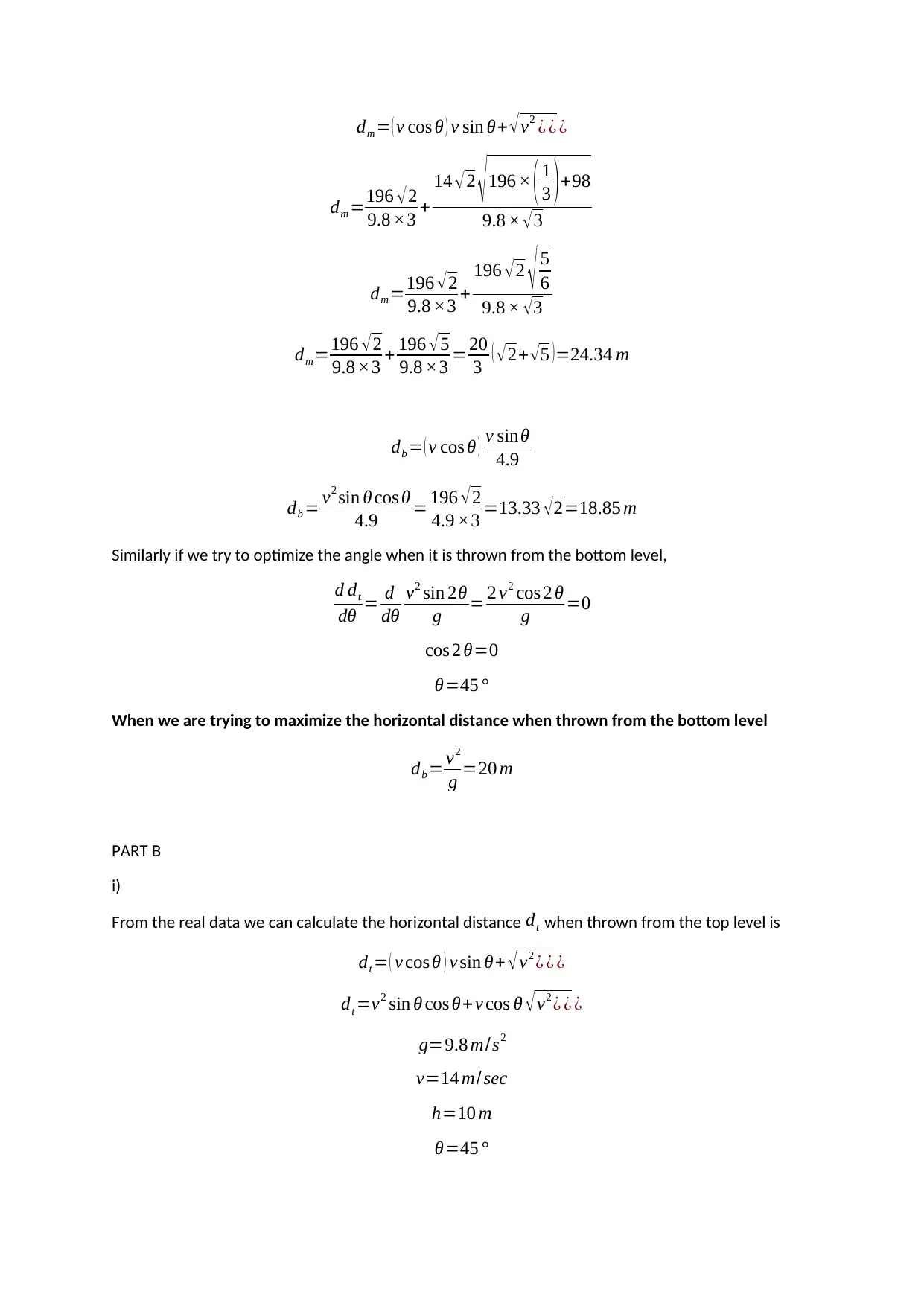
dm = ( v cos θ ) v sin θ+ √ v2 ¿ ¿ ¿
dm =196 √ 2
9.8 ×3 +
14 √ 2 √196 × ( 1
3 )+98
9.8 × √3
dm =196 √ 2
9.8 ×3 +
196 √ 2 √ 5
6
9.8 × √ 3
dm =196 √2
9.8 ×3 + 196 √5
9.8 ×3 = 20
3 ( √ 2+ √5 )=24.34 m
db = ( v cos θ ) v sinθ
4.9
db = v2 sin θ cos θ
4.9 = 196 √ 2
4.9 ×3 =13.33 √2=18.85 m
Similarly if we try to optimize the angle when it is thrown from the bottom level,
d dt
dθ = d
dθ
v2 sin 2θ
g = 2 v2 cos 2 θ
g =0
cos 2 θ=0
θ=45 °
When we are trying to maximize the horizontal distance when thrown from the bottom level
db = v2
g =20 m
PART B
i)
From the real data we can calculate the horizontal distance dt when thrown from the top level is
dt = ( v cos θ ) v sin θ+ √v2 ¿ ¿ ¿
dt =v2 sin θ cos θ+v cos θ √ v2 ¿ ¿ ¿
g=9.8 m/s2
v=14 m/ sec
h=10 m
θ=45 °
dm =196 √ 2
9.8 ×3 +
14 √ 2 √196 × ( 1
3 )+98
9.8 × √3
dm =196 √ 2
9.8 ×3 +
196 √ 2 √ 5
6
9.8 × √ 3
dm =196 √2
9.8 ×3 + 196 √5
9.8 ×3 = 20
3 ( √ 2+ √5 )=24.34 m
db = ( v cos θ ) v sinθ
4.9
db = v2 sin θ cos θ
4.9 = 196 √ 2
4.9 ×3 =13.33 √2=18.85 m
Similarly if we try to optimize the angle when it is thrown from the bottom level,
d dt
dθ = d
dθ
v2 sin 2θ
g = 2 v2 cos 2 θ
g =0
cos 2 θ=0
θ=45 °
When we are trying to maximize the horizontal distance when thrown from the bottom level
db = v2
g =20 m
PART B
i)
From the real data we can calculate the horizontal distance dt when thrown from the top level is
dt = ( v cos θ ) v sin θ+ √v2 ¿ ¿ ¿
dt =v2 sin θ cos θ+v cos θ √ v2 ¿ ¿ ¿
g=9.8 m/s2
v=14 m/ sec
h=10 m
θ=45 °
Paraphrase This Document
Need a fresh take? Get an instant paraphrase of this document with our AI Paraphraser
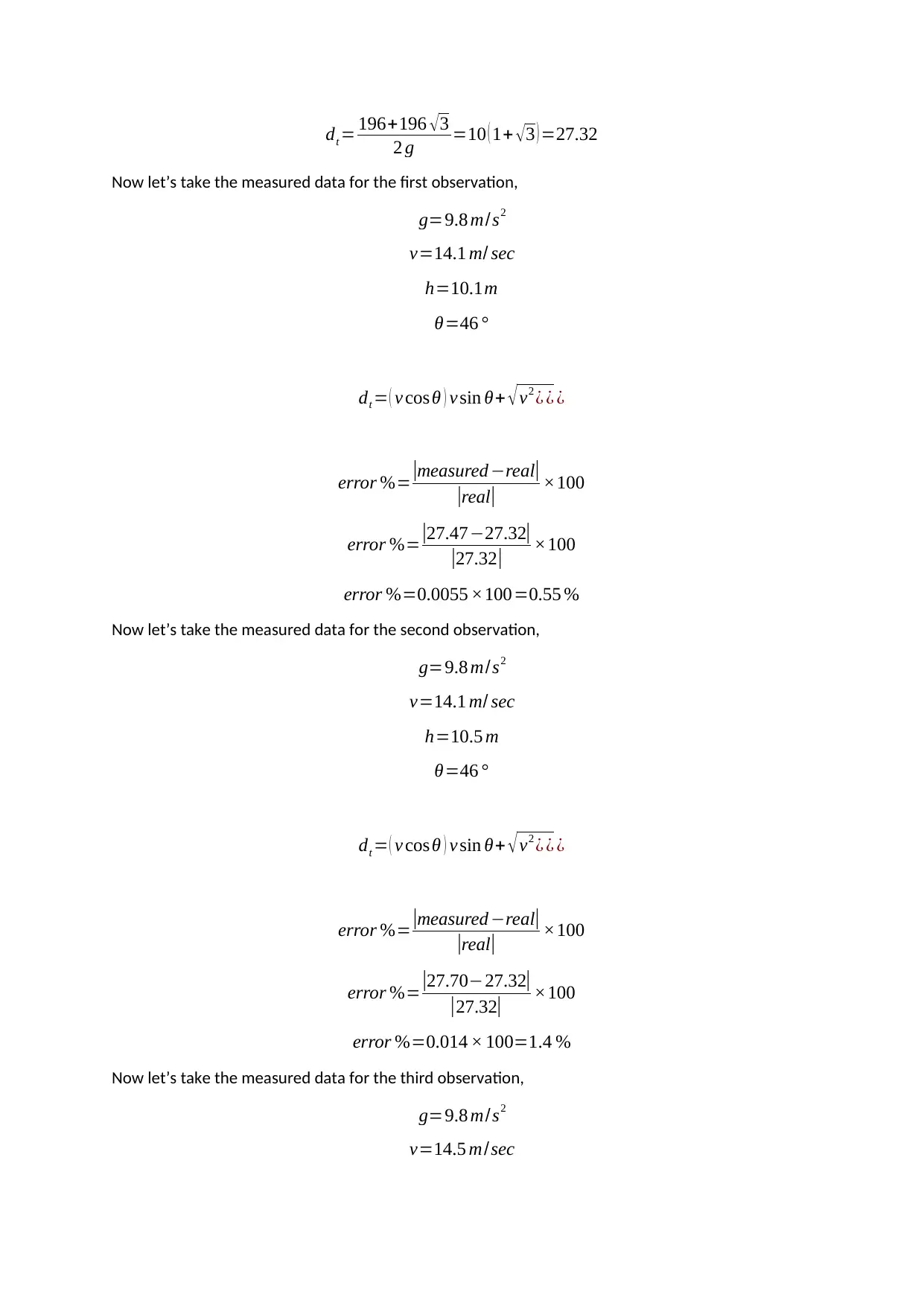
dt = 196+196 √3
2 g =10 ( 1+ √3 ) =27.32
Now let’s take the measured data for the first observation,
g=9.8 m/s2
v=14.1 m/ sec
h=10.1m
θ=46 °
dt = ( v cos θ ) v sin θ+ √v2 ¿ ¿ ¿
error %= |measured −real|
|real| ×100
error %= |27.47−27.32|
|27.32| ×100
error %=0.0055 ×100=0.55 %
Now let’s take the measured data for the second observation,
g=9.8 m/s2
v=14.1 m/ sec
h=10.5 m
θ=46 °
dt = ( v cos θ ) v sin θ+ √v2 ¿ ¿ ¿
error %= |measured −real|
|real| ×100
error %= |27.70−27.32|
|27.32| ×100
error %=0.014 × 100=1.4 %
Now let’s take the measured data for the third observation,
g=9.8 m/s2
v=14.5 m/sec
2 g =10 ( 1+ √3 ) =27.32
Now let’s take the measured data for the first observation,
g=9.8 m/s2
v=14.1 m/ sec
h=10.1m
θ=46 °
dt = ( v cos θ ) v sin θ+ √v2 ¿ ¿ ¿
error %= |measured −real|
|real| ×100
error %= |27.47−27.32|
|27.32| ×100
error %=0.0055 ×100=0.55 %
Now let’s take the measured data for the second observation,
g=9.8 m/s2
v=14.1 m/ sec
h=10.5 m
θ=46 °
dt = ( v cos θ ) v sin θ+ √v2 ¿ ¿ ¿
error %= |measured −real|
|real| ×100
error %= |27.70−27.32|
|27.32| ×100
error %=0.014 × 100=1.4 %
Now let’s take the measured data for the third observation,
g=9.8 m/s2
v=14.5 m/sec

h=10.1m
θ=46 °
dt = ( v cosθ ) v sin θ+ √ v2 ¿ ¿ ¿
error %= |measured−real|
|real| ×100
error %= |2 8.72−27.32|
|27.32| × 100
error %=0.051 ×100=5.1%
Now let’s take the measured data for the third observation,
g=9.8 m/s2
v=14.1 m/ sec
h=10.1m
θ=50°
dt = ( v cosθ ) v sin θ+ √ v2 ¿ ¿ ¿
error %= |measured−real|
|real| ×100
error %= |2 6.32−27.32|
|27.32| × 100
error %=0.036 ×100=3.6 %
Now let’s take the measured data for the third observation,
g=9.8 m/s2
v=14.1 m/ sec
h=10.1m
θ=4 0°
dt = ( v cosθ ) v sin θ+ √ v2 ¿ ¿ ¿
θ=46 °
dt = ( v cosθ ) v sin θ+ √ v2 ¿ ¿ ¿
error %= |measured−real|
|real| ×100
error %= |2 8.72−27.32|
|27.32| × 100
error %=0.051 ×100=5.1%
Now let’s take the measured data for the third observation,
g=9.8 m/s2
v=14.1 m/ sec
h=10.1m
θ=50°
dt = ( v cosθ ) v sin θ+ √ v2 ¿ ¿ ¿
error %= |measured−real|
|real| ×100
error %= |2 6.32−27.32|
|27.32| × 100
error %=0.036 ×100=3.6 %
Now let’s take the measured data for the third observation,
g=9.8 m/s2
v=14.1 m/ sec
h=10.1m
θ=4 0°
dt = ( v cosθ ) v sin θ+ √ v2 ¿ ¿ ¿
⊘ This is a preview!⊘
Do you want full access?
Subscribe today to unlock all pages.

Trusted by 1+ million students worldwide
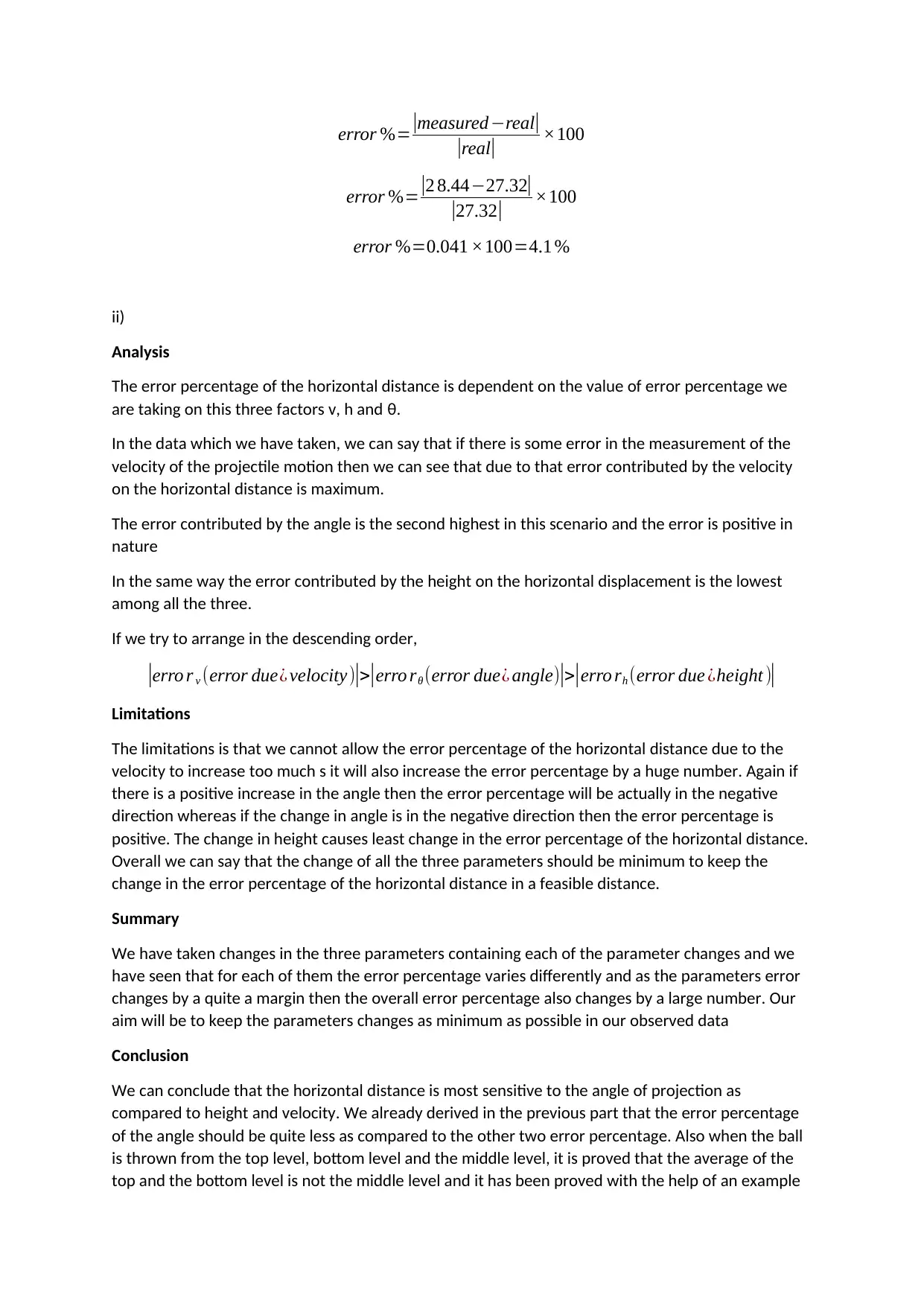
error %= |measured−real|
|real| ×100
error %= |2 8.44−27.32|
|27.32| ×100
error %=0.041 ×100=4.1 %
ii)
Analysis
The error percentage of the horizontal distance is dependent on the value of error percentage we
are taking on this three factors v, h and θ.
In the data which we have taken, we can say that if there is some error in the measurement of the
velocity of the projectile motion then we can see that due to that error contributed by the velocity
on the horizontal distance is maximum.
The error contributed by the angle is the second highest in this scenario and the error is positive in
nature
In the same way the error contributed by the height on the horizontal displacement is the lowest
among all the three.
If we try to arrange in the descending order,
|erro r v (error due¿ velocity)|>|erro rθ (error due¿ angle)|>|erro rh (error due ¿height )|
Limitations
The limitations is that we cannot allow the error percentage of the horizontal distance due to the
velocity to increase too much s it will also increase the error percentage by a huge number. Again if
there is a positive increase in the angle then the error percentage will be actually in the negative
direction whereas if the change in angle is in the negative direction then the error percentage is
positive. The change in height causes least change in the error percentage of the horizontal distance.
Overall we can say that the change of all the three parameters should be minimum to keep the
change in the error percentage of the horizontal distance in a feasible distance.
Summary
We have taken changes in the three parameters containing each of the parameter changes and we
have seen that for each of them the error percentage varies differently and as the parameters error
changes by a quite a margin then the overall error percentage also changes by a large number. Our
aim will be to keep the parameters changes as minimum as possible in our observed data
Conclusion
We can conclude that the horizontal distance is most sensitive to the angle of projection as
compared to height and velocity. We already derived in the previous part that the error percentage
of the angle should be quite less as compared to the other two error percentage. Also when the ball
is thrown from the top level, bottom level and the middle level, it is proved that the average of the
top and the bottom level is not the middle level and it has been proved with the help of an example
|real| ×100
error %= |2 8.44−27.32|
|27.32| ×100
error %=0.041 ×100=4.1 %
ii)
Analysis
The error percentage of the horizontal distance is dependent on the value of error percentage we
are taking on this three factors v, h and θ.
In the data which we have taken, we can say that if there is some error in the measurement of the
velocity of the projectile motion then we can see that due to that error contributed by the velocity
on the horizontal distance is maximum.
The error contributed by the angle is the second highest in this scenario and the error is positive in
nature
In the same way the error contributed by the height on the horizontal displacement is the lowest
among all the three.
If we try to arrange in the descending order,
|erro r v (error due¿ velocity)|>|erro rθ (error due¿ angle)|>|erro rh (error due ¿height )|
Limitations
The limitations is that we cannot allow the error percentage of the horizontal distance due to the
velocity to increase too much s it will also increase the error percentage by a huge number. Again if
there is a positive increase in the angle then the error percentage will be actually in the negative
direction whereas if the change in angle is in the negative direction then the error percentage is
positive. The change in height causes least change in the error percentage of the horizontal distance.
Overall we can say that the change of all the three parameters should be minimum to keep the
change in the error percentage of the horizontal distance in a feasible distance.
Summary
We have taken changes in the three parameters containing each of the parameter changes and we
have seen that for each of them the error percentage varies differently and as the parameters error
changes by a quite a margin then the overall error percentage also changes by a large number. Our
aim will be to keep the parameters changes as minimum as possible in our observed data
Conclusion
We can conclude that the horizontal distance is most sensitive to the angle of projection as
compared to height and velocity. We already derived in the previous part that the error percentage
of the angle should be quite less as compared to the other two error percentage. Also when the ball
is thrown from the top level, bottom level and the middle level, it is proved that the average of the
top and the bottom level is not the middle level and it has been proved with the help of an example
Paraphrase This Document
Need a fresh take? Get an instant paraphrase of this document with our AI Paraphraser
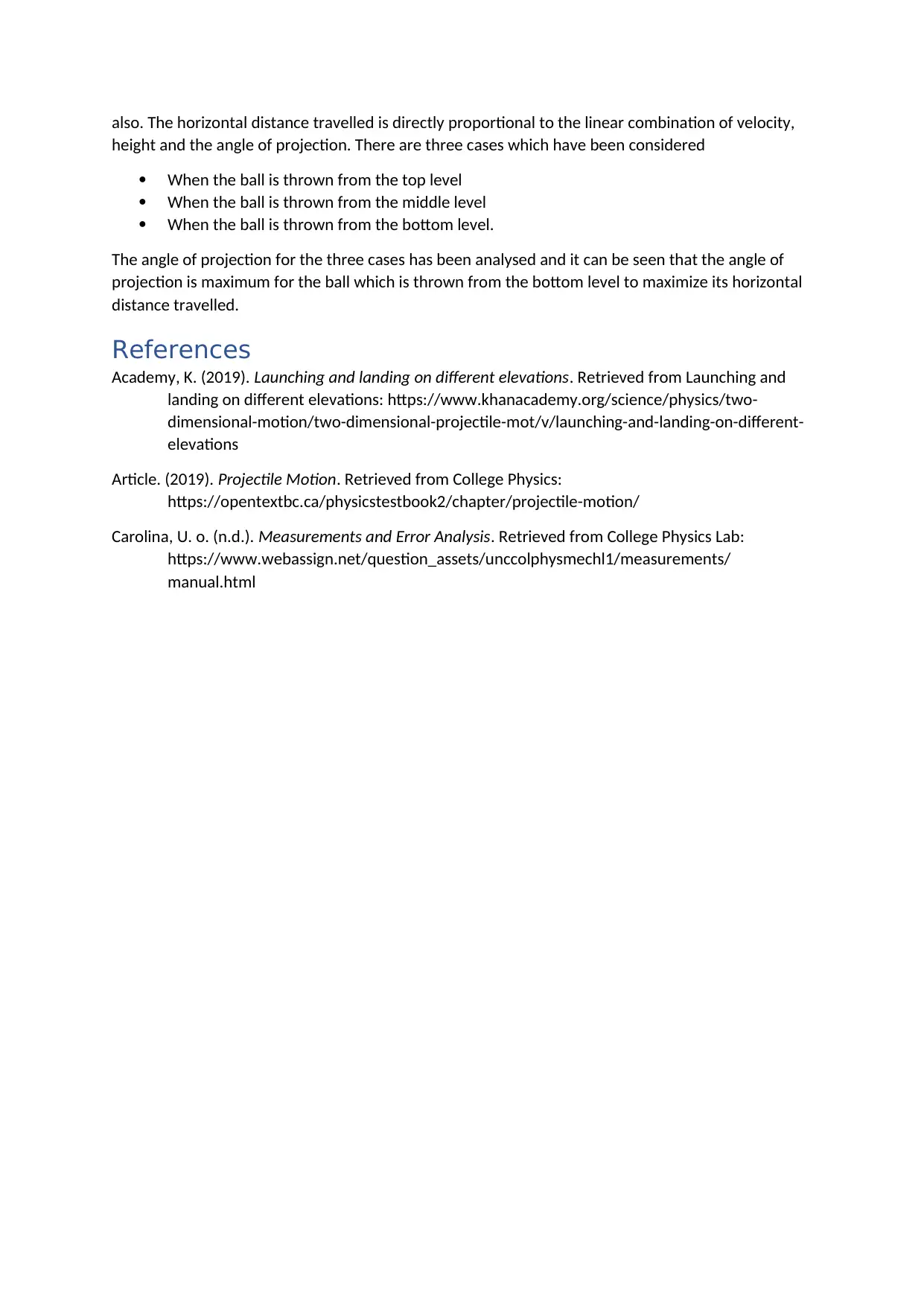
also. The horizontal distance travelled is directly proportional to the linear combination of velocity,
height and the angle of projection. There are three cases which have been considered
When the ball is thrown from the top level
When the ball is thrown from the middle level
When the ball is thrown from the bottom level.
The angle of projection for the three cases has been analysed and it can be seen that the angle of
projection is maximum for the ball which is thrown from the bottom level to maximize its horizontal
distance travelled.
References
Academy, K. (2019). Launching and landing on different elevations. Retrieved from Launching and
landing on different elevations: https://www.khanacademy.org/science/physics/two-
dimensional-motion/two-dimensional-projectile-mot/v/launching-and-landing-on-different-
elevations
Article. (2019). Projectile Motion. Retrieved from College Physics:
https://opentextbc.ca/physicstestbook2/chapter/projectile-motion/
Carolina, U. o. (n.d.). Measurements and Error Analysis. Retrieved from College Physics Lab:
https://www.webassign.net/question_assets/unccolphysmechl1/measurements/
manual.html
height and the angle of projection. There are three cases which have been considered
When the ball is thrown from the top level
When the ball is thrown from the middle level
When the ball is thrown from the bottom level.
The angle of projection for the three cases has been analysed and it can be seen that the angle of
projection is maximum for the ball which is thrown from the bottom level to maximize its horizontal
distance travelled.
References
Academy, K. (2019). Launching and landing on different elevations. Retrieved from Launching and
landing on different elevations: https://www.khanacademy.org/science/physics/two-
dimensional-motion/two-dimensional-projectile-mot/v/launching-and-landing-on-different-
elevations
Article. (2019). Projectile Motion. Retrieved from College Physics:
https://opentextbc.ca/physicstestbook2/chapter/projectile-motion/
Carolina, U. o. (n.d.). Measurements and Error Analysis. Retrieved from College Physics Lab:
https://www.webassign.net/question_assets/unccolphysmechl1/measurements/
manual.html
1 out of 8
Related Documents
Your All-in-One AI-Powered Toolkit for Academic Success.
+13062052269
info@desklib.com
Available 24*7 on WhatsApp / Email
![[object Object]](/_next/static/media/star-bottom.7253800d.svg)
Unlock your academic potential
Copyright © 2020–2025 A2Z Services. All Rights Reserved. Developed and managed by ZUCOL.





